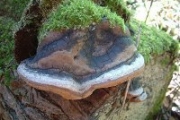Viewings: 6954

Recently biologists have found that many millions of years ago the education of coal on Earth ceased due to the activity of fungi. These organisms in the process of evolution had the ability to break down the lignin - matter of the shells of plant cells. After that coal was already no form: mushrooms ate the whole thing.
How on Earth from 400 to 280 million years ago appeared coal? As we remember, at the end of the Paleozoic era (and if specifically, in Devon) occurred a significant event: the land on which to live only algae, lichens and invertebrates, began to settle in higher plants. With the new environment so they liked that in the next period - Carboniferous - on the desert before continents already wore these forests of treelike ferns, horsetails, club moss, primitive gymnosperms and representatives of other groups, who later became extinct.
At the same time, plants, without knowing it, his appearance on land provoked one of the first ecosystem crises. The fact that they, like other living beings, sometimes tend to die. However, their trunks and other parts of the body had not decomposed, simply because then on the Earth there was no one to do it. In the end, vegetable remains, fallen into the swamp for a long time remained intact, and then kamerali. And formed coal, for which mankind are still grateful inhabitants of the Paleozoic era.
This unpaid loss of ecosystem carbon has not gone unnoticed. Because of higher plants regularly photosynthetically, that is produced oxygen. But since their dead organic decay, it was not spent. The result has accumulated in the atmosphere excessive amounts of this gas, which led to a major glaciations on the border of the Carboniferous and Permian, for the formation of glaciers occurs whenever the oxygen quantity exceeds carbon dioxide. So the imperfection of the ecosystem carbon cycles have spoiled the earth's climate.
But why are the remains of higher plants nobody was dissolved? In fact, according to paleontologists, on the land, then grabbed and bacteria, and fungi, which perform the role of destructors in terrestrial ecosystems. Most likely, it was not quantity, but quality: these organisms could not cope with lignin is a substance included in the composition of plant cell membranes. Well, if you are unable to destroy the shell, and other substances also not be reached. That is why coal and could with impunity be formed in the next few million years.
On the other hand, scientists already knew that then existed mushrooms, which could produce energy from cellulose. Therefore, they suggested that, apparently, at the end of the Carboniferous some of them have gained in the process of evolution, the ability to decompose this inedible lignin. As a result, the crisis of young ecosystems has been successfully overcome: buy ognenanastasovski enzymes, mushrooms finally able to get to "delicious" cellulose. Having a very clear that as soon as this happened, the formation of coal has stopped.
But what kind of mushrooms to the first "guessed" to get such a useful enzyme? Biologists have assumed that it could do the representatives of Klaas garikovich (Agaricomycetes), which include our favorite white mushrooms, aspen mushrooms, chanterelles, and unloved the mushrooms and toadstools. It has long been known that many of them have the enzymes that break down the lignin and cellulose. By the way, among them are "professional" destructors of wood - for example, trudoviki or mushrooms of the genus Coniothyrium that cause such a disease of plants, as white rot.
And here experts from the international group of mycologists decided to find out whether agricolae mushrooms were able to stop the process of formation of coal in the Paleozoic era. They analyzed the genomes of thirty-one representative class garikovich, to find out when exactly this group appeared destructive lignin enzymes. During the study assessed the rate of accumulation of mutations of different species, as well as the similarity of these mutations.
In the end it turned out that some of the most ancient ancestor of all apartamentow really was similar to the present representatives of the genus Coniothyrium, that is, could cause the white rot. This fungus has already had adopted the complete set of proteins that can destroy the lignin. And, most interesenoe, he appeared about 300 million years ago, at the end of the Carboniferous, when preobrazovanie already beginning to fade.
Apparently, these mushrooms and stopped the formation of coal that has been decomposing remains of plants. Further, the evolution garikovich proceeded as follows: some of them have lost razlagalsa ability, because he preferred to establish a symbiotic relationship with plants. From these mushrooms originate those who are now forming on the roots of plants mycorrhiza. But here other enzymes are the destroyers of lignin preserved their descendants are trudoviki and pathogens white rot.
So, as you can see, it is because of the activities of the Paleozoic mushrooms humanity is not enough coal. But do not be offended - they helped young terrestrial ecosystems to get out of the first crisis, and for a while he stopped cold. And in the woods and on the fields of their activity has become much cleaner. In addition, mushrooms started to return vegetable carbon in the soil, causing productivity only increased. So, we can say to them we owe the opportunity to engage in agriculture.
However, now agricolae can also solve the problem of impending energy crisis. The fact that scientists want to find quick and cheap way to make biofuels. Well, as the most promising biofuels are produced by the yeast alcohols, here agricolae with their enzymes that destroy the lignin and cellulose, could help. They quickly would provide yeast huge number of simple sugars obtained from the rough wood. It only remains to establish the production cycle, in which will take part the representatives of both groups of fungi.
















